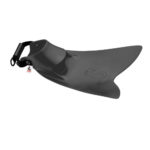“Force Fin swimming fins are designed to concentrate the force of the blade further back on the foot, using the muscles of the whole leg, not just the lower leg.”

While seated, cross your ankle over your knee, grab your toes and pull them in the direction of the sole of your foot. Do you feel the stretch and tension running from the top of your foot up and along the shin? Those are the primary muscles that other fins work because the fin blade extends from your toes

Now, grab the foot in both hands – one holding the heel, the other holding the top of the foot – pull again toward the sole of the foot and resist with the leg. The tension has moved up to the upper leg, hasn’t it? Because of their unique design based on human biomechanics, Force Fins and Slim Fins work the larger muscles of the upper leg in addition to the lower leg. These are the muscle groups you need to develop for a strong kick and a better workout.
WHY SWIM WITH FINS?
Increase fitness and cardiovascular conditioning
Although swimming is considered one of the best aerobic or cardiovascular-conditioning exercises, many people forget to use their legs where the largest muscles are located. Since the greatest cardiovascular benefits come from including the highest percentage of the body’s muscles – that’s why cross-country skiing and rowing are considered two of the most demanding sports – it makes sense that swimmers who activate the large muscle mass of the legs by kicking will benefit from a more demanding workout that burns more calories and increases fitness levels.
Add fins to the equation and the increased load they add to the legs means that as long as exertion levels remain high, the cardiovascular system gets an even more intense workout with even greater fitness benefits.
Unlike all other fins, even those with open toe drains, only Force Fin swimming fins are designed to concentrate the force of the blade further back on the foot, using the muscles of the whole leg, not just the lower leg.
Increase ankle flexibility
Good swimmers, on the other hand, can hyperextend (plantar flex) their ankles, pointing their toes so that the top of the foot forms a straight line with the shin. Because of the extra load from the increased surface area that fins provide, swimming or kicking with fins forces ankle extension during the power phase (pushing down when swimming freestyle) of the kick. Repeated fin use eventually stretches the ankles, increasing their flexibility for moving in all directions and helping the kick become more propulsive and efficient.
Have you ever noticed that runners, cyclists, or triathletes new to swimming who start a serious swim program have a hard time just kicking and going anywhere? In fact, they sometimes go backward! One reason is that their ankles are so inflexible that when they kick, their feet act like hooks, catching the water and pulling the frustrated swimmer in the wrong direction.
The extra load from the increased surface area that fins provide, swimming or kicking with fins forces ankle extension during the power phase (pushing down when swimming freestyle) of the kick. Repeated fin use eventually stretches the ankles, increasing their flexibility for moving in all directions and helping the kick become more propulsive and efficient

Ankle flexibility is one key to efficient kicking. To measure your flexibility, sit on the floor with legs extended and place a stiff piece of paper against the side of the foot. With heels touching the floor, point your toes as far forward as you can while having someone trace this side view.
Measure the distance from the base of your big toe to the ground or floor; your goal should be from one to four inches.
Using a regular program of kicking with FORCE FIN swimming fins, re-measure and chart your progress.
Develop leg and swim kick strength
Kicking with fins is like lifting weights: the added resistance of the water on the blade of the fin increases the workload on your leg muscles. Your body adapts by increasing the strength and endurance of the muscles involved. Stronger muscles move more water making you swim faster, all other things being equal.
A word about specificity: It’s important to realize that muscular strength for swimming needs to be “specific.” Good runners, cyclists, roller bladers, etc. can have very strong leg muscles, but the muscles have developed for running, cycling or roller blading, not for swimming. Fins develop leg strength specifically for swimming, and in a way that few other activities can.
“Force Fin swimming fins utilize the body’s strength and put it where it’s needed. The human body is built to have more strength when kicking down (during freestyle), than when kicking up. The downward or power phase of the kick emphasizes the powerful quadriceps muscle group at the front and side of the upper leg. The upward, recovery phase uses the weaker hamstrings at the back of the thigh. While still developing both sets of muscles, our blade design assists — or helps take the load off — the upward recovery phase that uses the weaker muscles, maximizing energy efficiency.”
Improve body position and technique so you can swim fast
Fins add extra propulsion to the stroke, which increases a swimmer’s speed through the water. Good swimmers tend to plane on top of the water while poor swimmers tend to drag their legs and swim in a more vertical position slowing them down. One of the goals of swimming faster with fins is to swim faster when the fins are taken off! By transferring the feeling of swimming faster and higher with fins to swimming without them, a swimmer makes use of a phenomenon know as neuromuscular patterning. The muscles and the nerves can actually remember the feeling of swimming faster and will try to duplicate the pattern the next time out. The more times the pattern is repeated (swimming faster and higher in the water with fins), the easier it is to duplicate it. The end result: the swimmer’s technique and neuromuscular coordination improves.
Why Swim With Force Fin Slim Fins?
We’ve been designing and making improvements to fins for over 25 years, with hundreds of thousands of satisfied customers, and many major product design awards under our belts, we can honestly say that we are the experts in fin design. That’s all we do, and we think our innovative fins are without equal in terms of comfort, efficiency, durability, performance, versatility and sheer value for your money.
We offer a variety of fins and each as been developed in response to your needs, comments and suggestions. Studying marine animal locomotion and human biomechanics, we have researched and designed our fins to take advantage of the laws of nature and physics. Not to mention common sense.
Patented Toe Pocket Design
Unlike all other fins, even those with open toe boxes, only FORCE FIN swimming fins are designed to concentrate the force of the blade further back on the foot, using the muscles of the whole leg, not just the lower leg.
Patented Blade Design
Our fins do not have flat blades like most other brands. Instead the blade curves up or away from the bottom of your foot to provide more resistance on the power or downward (during freestyle) phase of the kick. The blade then snaps back to assist on the recovery. This two-stroke cycle does several things for a swimmer:
Have you ever seen a fast-swimming fish with a blunt or squared-off tail? Neither had we. That’s why we patterned our fins after the split-V shape of fish tails that more efficiently channel the water. The other brands of swimming fins still use the cheaper-to-make, straight-across design.
We also noticed that other fins worked basically like boards tied to your feet; they were stiff and inflexible. Again, we took our cue from nature and physics, and we came up with very flexible fins using innovative materials like polyurethane instead of rubber.
The snap of the blade helps increase kicking tempo keeping correct arms-to-legs coordination intact. There’s no worry about the kick slowing down unnaturally as with all other fins.
The rebound of the blade during the recovery phase helps bring the legs higher in the water (during free-style), raising the lower body to the surface in the desirable high-in-the-water position, where you encounter less drag and can swim faster and more efficiently.
Force Fin swimming fins utilize the body’s strength and put it where it’s needed. The human body is built to have more strength when kicking down (during freestyle), than when kicking up. The downward or power phase of the kick emphasizes the powerful quadriceps muscle group at the front and side of the upper leg. The upward, recovery phase uses the weaker hamstrings at the back of the thigh. While still developing both sets of muscles, our blade design assists — or helps take the load off — the upward recovery phase that uses the weaker muscles, maximizing energy efficiency. Conventional fins make your legs work as hard on the recovery as on the power phase of the cycle, because the flat rigid fins must push aside water to get back into position.
By kicking against a load that provides for a separate power and recovery cycle as opposed to the traditional power-power cycle of other fins, oxygen depletion is reduced, the legs and body work more aerobically and less anaerobically, and swimmers can maintain their workout efforts for longer periods of time. Independent research has shown less lactic acid buildup (lactic acid is the proof of anaerobic activity) and more oxygen absorption with Force Fins. Flat fins bring on symptoms of fatigue and cramping more quickly.
Other fins, flat fins want to go through the water along the path of least resistance, which is sideways! Don’t believe it? Hold a flat, heavy object at the surface of the water, let go and watch what happens. It turns on its edge and heads for the bottom. Or, if it’s light like a sheet of paper, it will zig-zag or “dish” its way down. Neither action is going to help your kicking. With flat fins – even small or cutoff flat fins – a swimmer is constantly fighting all this twisting and torquing, and any effort spent this way is wasted.
The curves and flexibility of our blade design help keep the legs properly oriented for more efficient power, even as they fatigue.
FORCE FINS or SLIM FINS?
Force Fins are our original design, and being somewhat larger than Slim Fins, they provide a more concentrated leg workout (more resistance). They are a more versatile fin, in that they can be used for other sports, such as snorkeling, SCUBA and float tube fishing. From a swimming perspective, they are a very specific training tool and are excellent for butterfly, “new-wave” breaststroke, and the backstroke dolphin kick.
Slim Fins are narrower than the Force Fin and are specifically designed for pool swimming – especially freestyle – applications. With Slim Fins, the blades don’t touch, flip turns are no problem, and high stroke turnover or cadence is easily maintained. Slim Fins can be used either while swimming or in kicking-only drills. They receive the highest recommendations from swimming coaches and professionals, and will do the best job for and are probably the best choice for most swimmers.
HOW ARE THEY MADE?
Manufactured in the USA and backed by 20 years of research and development, Force Fin swimming fins are made of ultraviolet-, abrasion- and chemical-resistant polyurethane and heat-treated for 16 hours at temperatures where other fins melt. This process allows the molecules to cross-link giving the blade its snappy, high-performance characteristics and extreme durability. Unlike other brands, Force Fin swimming fins will not melt on hot pool decks or mark the sides of pools, and should last season after season, even when used daily. We could go on forever describing the unique benefits of using Force Fin swimming fins to improve your swimming. But there’s only one way to really find out why our fins are the best swimming fins in the world: try a pair you will be happy!




Bob Evans, Thank you for the Thank you card on my recent purchase of the Original Force Fin in size XXXL for use with my Bare Trilam Dry suit and Sz 14 foot. I have yet to receive a thank you card from other SCUBA Diving manufacturers. Just sayin’.
Here’s what I want ….. This requests a bigger (wider) sized insert for the XXXL fin.
Background:
I’ve been an Original Force Fin diver for over 10 years, both for recreational use in as a PADI OW Instructor and Master Scuba Diver Trainer. … I have a lot of experience with the fin. I wear an Atomic blade fin for my confined water teaching and maybe first day of Open Water confirmation dives. Why? Beacause that is what my Dive Center sells. However, I wear the Force fin as soon as possible with a students.
I have the standard sized insert for the Original Force fins and have used it with my XL (w/no booties) or my XXL with 3 Mil booties. No insert is needed for my XXL Original Force fins with my 5 Mil boots.
I’ve purchased a Bare Dry suit with molded Neoprene Boot (hard sole). My XXL fins are quite snug with 1 pair of socks and way too snug with 2 pair of socks for added warmth. …… Thus my purchase of the XXXL Force Fin. I need to use and do use the insert with the XXXL fins and my Dry Suit, but …. the foot pocket is still a little sloppy, more so than my other combinations.
What I am asking for is a larger insert wider, (wider such that wraps farther around my foot) and, perhaps, thicker.). I’d make what I think I need if you could supply the material. Or…. Make for for me and sell it to me. Or …. tell me the Extra ForceFin’s foot pocket insert IS BIGGER and will suit my needs.
Doug Rencher
More about the differences btwn original and slim fins please
FORCE FINS or SLIM FINS?
Force Fins are our original design, and being somewhat larger than Slim Fins, they provide a more concentrated leg workout (more resistance). They are a more versatile fin, in that they can be used for other sports, such as snorkeling, SCUBA and float tube fishing. From a swimming perspective, they are a very specific training tool and are excellent for butterfly, “new-wave” breaststroke, and the backstroke dolphin kick.
Slim Fins are narrower than the Force Fin and are specifically designed for pool swimming – especially freestyle – applications. With Slim Fins, the blades don’t touch, flip turns are no problem, and high stroke turnover or cadence is easily maintained. Slim Fins can be used either while swimming or in kicking-only drills. They receive the highest recommendations from swimming coaches and professionals, and will do the best job for and are probably the best choice for most swimmers.
Slim Fin Blade Size in Relation to foot and leg – note there is some perspective focusing on the Slim Fin that makes it appear larger/wider than it is.